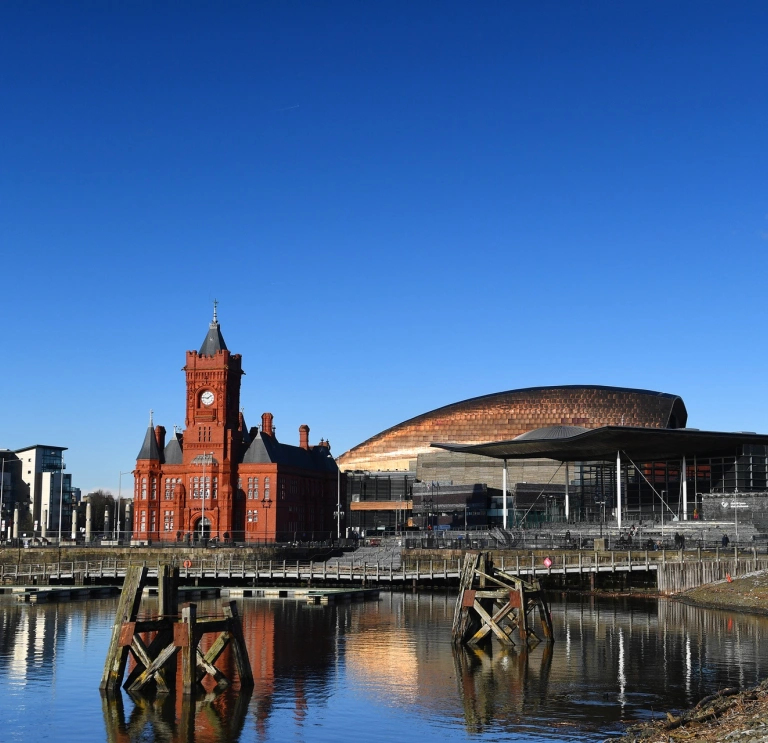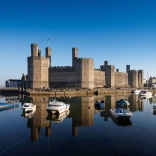Strolling past the craft breweries and fine-dining restaurants that line Cardiff’s wide pedestrianised avenues, it’s easy to believe the city has always been Wales’s cosmopolitan capital.
But, while this may be one of Europe’s youngest capital cities, Cardiff has lived many lives, from Roman military outpost to thriving market town to giant industrial coal port, before transforming itself yet again into the modern metropolis that routinely enchants visitors today. As coming-of-age stories go, it’s certainly a colourful one.
Where it all began
For all of Cardiff’s modern sheen, there is one obvious clue that points to the city’s storied past: the great big castle right in its centre. The stronghold, which has become an emblem of the city, was initially built by the Romans when they roamed around Wales in around AD50. It was rebuilt and expanded on by the Normans and embellished during the Victorian era, when opulent interiors – which are open for visitors to have a nose around – were added.
While it's the most famous monument in the city, Cardiff is no stranger to historic relics, with a scattering of Bronze Age burial mounds and Stone Age monoliths (such as the one at St Lythans) located within its boundaries, which point to human settlement in the region as far back as 4000BC. The fact the city is home to an abundance of – now mostly ruined – fortresses has also led some to claim Cardiff has the most castles of any city in the world (but we’ll let you make up your own mind on that one).



Canals, coal and conscientious town planning
Following the withdrawal of the Romans from Wales in the 5th century, Cardiff’s fortunes fluctuated wildly. The settlement became a thriving market town in the 14th century, only to be burnt to the ground during Owain Glyndwr’s ill-fated revolt against the English in the 15th century. (Despite this minor transgression, a statue to the fabled Welsh figure stands today in Cardiff City Hall.)
However, the real turning point for Cardiff came with the completion of the Glamorganshire Canal in 1798. By providing a direct link between the town’s nascent dock complex on the Severn Estuary and the coal mines of the South Wales Valleys, the canal kickstarted Cardiff’s game-changing transformation into a major coal port. In less than a century, Cardiff’s dock network would become the largest in the world in terms of the tonnage of exports. This led to a swell in population and influx of immigration from around the world, with no less than 57 different nationalities being recorded among the city's residents in the early 1900s.
The Cardiff docks project was spearheaded, and largely financed, by John Crichton-Stuart, 2nd Marquess of Bute. The Butes had come to own much of Cardiff’s land in the late 18th century, including Cardiff Castle, and used it to expand the town, helping Cardiff to gain official city status in 1905 (the first town in Wales to gain official city status!).
However, while the Butes were instrumental in Cardiff’s industrialization, the family were so wealthy they could afford to leave vast tracts of land empty for recreational use, including Bute Park and Sophia Gardens (the latter named after the 2nd Marquess of Bute’s wife). The result is that, today, Cardiff has perhaps the greenest centre of any city in Europe.


Becoming the capital
Cardiff’s link with the Crichton-Stuart family came to an end in 1947, when the 5th Marquess of Bute gifted the castle and its surrounding parks to the city. It was around this time that Cardiff was vying to take on a new guise, aiming to step away from its role as the country’s industrial export hub and instead serve as the shining new capital city of Wales.
Prior to the 1950s, Wales did not have a recognised capital city. Polls conducted by newspapers in the preceding decades showed a desire for the country to have a capital, but councils were split on where it should be, with Caernarfon, Aberystwyth and Swansea all making compelling claims to be a candidate for the role.
However, after much debate, Cardiff eventually won out, being officially announced as the capital of Wales in 1955. Following the announcement, the city became home to a number of national institutions, including the Arts Council of Wales, Sport Wales National Centre, and, later on, the Senedd, headquarters of the Welsh Government.


A 21st century city
Present-day Cardiff is an exciting, multicultural city, teeming with shops, boutiques, bars and restaurants, both in the city centre, its adjacent suburbs, and in Cardiff Bay, the latter the result of an ambitious project that redeveloped a large section of the city’s dockyard into a leisure complex and freshwater lake.
The Welsh capital also boasts a strong creative sector, with large film studios, such as Wolf Studios, aiding in the production of Hollywood blockbusters and organisations like the Welsh National Opera and National Theatre Wales putting on thought-provoking productions throughout the year. The city is also famed for the Principality Stadium, uniquely located slap-bang in the centre of the city, which makes Cardiff one of the best places to watch rugby anywhere in the world.
Of course, mementos also remain from the city’s past. The Coal Exchange Hotel, where the international price of coal was set and the world’s first £1 million deal was brokered, harks back to the city’s industrial past, while the wonderful Cardiff Market, the site of goods trading since the 18th century, maintains a connection with the city’s market town roots. And of course, you can’t miss the castle – an ever-present reminder of just how far Cardiff has come.





